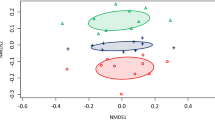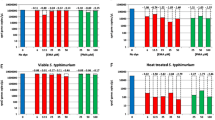Abstract
Real-time PCR (qPCR) is a rapid tool to quantify pathogens in the aquatic environment; however, it quantifies all pathogens, including both viable and nonviable. Propidium monoazide (PMA) is a membrane-impairment dye that penetrates only membrane-damaged cells. Once inside the cell, PMA is covalently cross-linked to DNA through light photoactivation, and PCR amplification is strongly inhibited. The goal of this study was to evaluate PMA-qPCR assays for rapid quantification of viable and heat-treated Giardia cysts and Cryptosporidium oocysts in wastewater. We observed a reduction in detection of heat-treated Giardia duodenalis cysts of 83.2, 89.9, 98.2, or 97 % with PMA-qPCR assays amplifying a 75 base-pair (bp) β-giardin target, 77-bp triosephosphate isomerase (tpi), 133-bp glutamate dehydrogenase (GDH), and 143-bp β-giardin gene target, respectively. Thus, the exclusion of dead cysts was more effective when qPCR assays that produced larger amplicons were used. The PMA treatment of Cryptosporidium oocysts plus/minus heat treatment abolished the fluorescent signal for dead oocysts with a PMA-qPCR assay amplifying a Cryptosporidium parvum (150-bp) oocyst wall protein (COWP) gene. The PMA-qPCR 143-bp β-giardin assay for Giardia and the PMA-qPCR 150-bp COWP assay for Cryptosporidium accurately quantified live oo(cysts), and failed to detect dead oo(cysts), when phosphate-buffered saline and tertiary effluent wastewater were spiked with concentrations of 103 or 102 dead oo(cysts), respectively. Therefore, these assays are suitable for the detection of viable parasites that are typically present in tertiary wastewater effluents at concentrations of <103 oo(cysts)/l and can provide rapid risk assessments of environmental water





Similar content being viewed by others
References
Agulló-Barceló M, Moss JA, Green J, Gillespie S, Codony F, Lucena F, Nocker A (2014) Quantification of relative proportions of intact cells in microbiological samples using the example of Cryptosporidium parvum oocysts. Lett Appl Microbiol 58:70–78
Agusti G, Codony F, Fittipaldi M, Adrados B, Morató J (2010) Viability determination of Helicobacter pylori using propidium monoazide quantitative PCR. Helicobacter 15:473–476
Almeida A, Pozio E, Cacciò SM (2010) Genotyping of Giardia duodenalis cysts by new real-time PCR assays for detection of mixed infections in human samples. Appl Environ Microbiol 76:1895–1901
Alonso JL, Amorós I, Cañigral I (2011) Development and evaluation of a real-time PCR assay for quantification of Giardia and Cryptosporidium in sewage samples. Appl Microbiol Biotechnol 89:1203–1211
Baldursson S, Karanis P (2011) Waterborne transmission of protozoan parasites: a review of worldwide outbreaks—an update 2004–2010. Water Res 45:6603–6614
Baque RH, Gilliam AO, Robles LD, Jakubowski W, Slifko TR (2011) A real-time RT-PCR method to detect viable Giardia lamblia cysts in environmental waters. Water Res 45:3175–3184
Belosevic M, Guy RA, Taghi-Kilani R, Neumann NF, Gyürek LL, Liyanage LRJ, Millards PJ, Finch GR (1997) Nucleic acid stains as indicators of Cryptosporidium parvum oocyst viability. Int J Parasitol 27:787–798
Brescia CC, Griffin SM, Ware MW, Varughese EA, Egorov AI, Villegas EN (2009) Cryptosporidium propidium monoazide-PCR, a molecular biology-based technique for genotyping of viable Cryptosporidium oocysts. Appl Environ Microbiol 75:6856–6863
Cacciò SM, De Giacomo M, Aulicino FA, Pozio E (2003) Giardia cysts in wastewater treatment plants in Italy. Appl Environ Microbiol 69:3393–3398
Contreras PJ, Urrutia H, Sossa K, Nocker A (2011) Effect of PCR amplicon length on suppressing signals from membrane-compromised cells by propidium monoazide treatment. J Microbiol Methods 87:89–95
Fittipaldi M, Rodriguez NJ, Codony F, Adrados B, Peñuela GA, Morató J (2010) Discrimination of infectious bacteriophage T4 virus by propidium monoazide real-time. J Virol Methods 168:228–232
Fittipaldi M, Rodriguez NJ, Adrados B, Agustí G, Peñuela G, Morató J, Codony F (2011) Discrimination of viable Acanthamoeba castellani trophozoites and cysts by propidium monoazide real-time polymerase chain reaction. J Eukaryot Microbiol 58:359–364
Fittipaldi M, Nocker A, Codony F (2012) Progress in understanding preferential detection of live cells using viability dyes in combination with DNA amplification. J Microbiol Methods 91:276–289
Guy RA, Payment P, Krull UJ, Horgen PA (2003) Real-time PCR for quantification of Giardia and Cryptosporidium in environmental water samples and sewage. Appl Environ Microbiol 69:5178–5185
Guy RA, Kapoor A, Holicka J, Shepherd D, Horgen PA (2006) A rapid molecular-based assay for direct quantification of viable bacteria in slaughterhouses. J Food Protect 69:1265–1272
Liang Z, Keeley A (2012) Comparison of propidium monoazide-quantitative PCR and reverse transcription quantitative PCR for viability detection of fresh Cryptosporidium oocysts following disinfection and after long-term storage in water samples. Water Res 46:5941–5953
Liu A, Ji H, Wang E, Liu J, Xiao L, Shen Y, Li Y, Zhang W, Ling H (2011) Molecular identification and distribution of Cryptosporidium and Giardia duodenalis in raw urban wastewater in Harbin, China. Parasitol Res 109:913–918
Nocker A, Camper AK (2009) Novel approaches toward preferential detection of viable cells using nucleic acid amplification techniques. FEMS Microbiol Lett 291:137–142
Nocker A, Cheung C-Y, Camper AK (2006) Comparison of propidium monoazide with ethidium monoazide for determination of live vs. dead bacteria by selective removal of DNA from dead cells. J Microbiol Methods 67:310–320
Opel KL, Chun D, McCord BR (2010) A study of PCR inhi-bition mechanisms using real time PCR. J Forensic Sci 55:25–33
Reynolds KA, Mena KD, Gerba CP (2008) Risk of waterborne illness via drinking water in the United States. Rev Environ Contam Toxicol 192:117–158
Robertson LJ, Casaert S, Valdez-Nava Y, Ehsan MA, Claerebout E (2014) Drying of Cryptosporidium oocysts and Giardia cysts to slides abrogates use of vital dyes for viability staining. J Microbiol Methods 96:68–69
Smith AL, Smith HV (1989) A comparison of fluorescein diacetate and propidium iodide staining and in vitro excystation for determining Giardia intestinalis cyst viability. Parasitology 99:329–331
Smith HV, Cacciò SM, Cook N, Nichols RAB, Tait A (2007) Cryptosporidium and Giardia as foodborne zoonoses. Vet Parasitol 149:29–40
Sulaiman IM, Fayer R, Bern C, Gilman RH, Trout JM, Schantz PM, Das P, Lal AA, Xiao L (2003) Triosephosphate isomerase gene characterization and potential zoonotic transmission of Giardia duodenalis. Emerg Infect Dis 9:1444–1452
Sulaiman IM, Jiang J, Singh A, Xiao L (2004) Distribution of Giardia duodenalis genotypes and subgenotypes in raw urban wastewater in Milwaukee, Wisconsin. Appl Environ Microbiol 70:3776–3780
Vesper S, McKinstry C, Hartmann C, Neace M, Yoder S, Vesper A (2008) Quantifying fungal viability in air and water samples using quantitative PCR after treatment with propidium monoazide (PMA). J Microbiol Methods 72:180–184
Acknowledgments
This work was supported by the Spanish Ministerio de Ciencia e Innovación, grant AGL2008-05275-C03-03/ALI. It was also financed, in part, by the Public Health Agency of Canada.
Author information
Authors and Affiliations
Corresponding author
Rights and permissions
About this article
Cite this article
Alonso, J.L., Amorós, I. & Guy, R.A. Quantification of viable Giardia cysts and Cryptosporidium oocysts in wastewater using propidium monoazide quantitative real-time PCR. Parasitol Res 113, 2671–2678 (2014). https://doi.org/10.1007/s00436-014-3922-9
Received:
Accepted:
Published:
Issue Date:
DOI: https://doi.org/10.1007/s00436-014-3922-9




